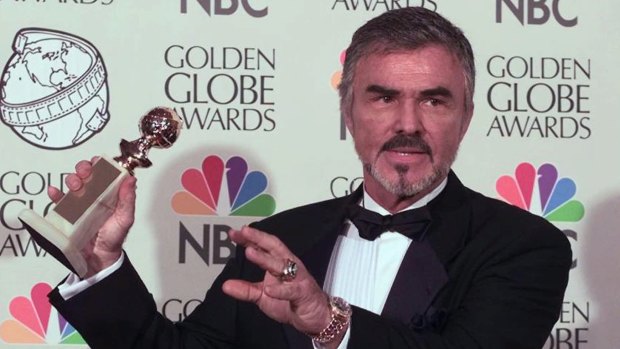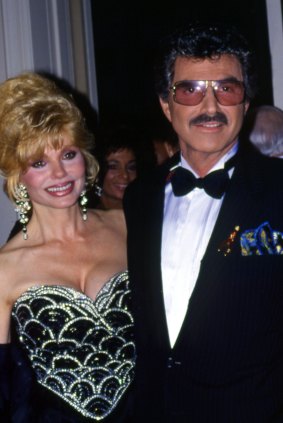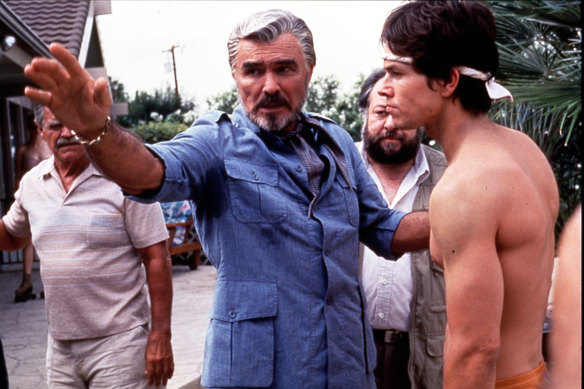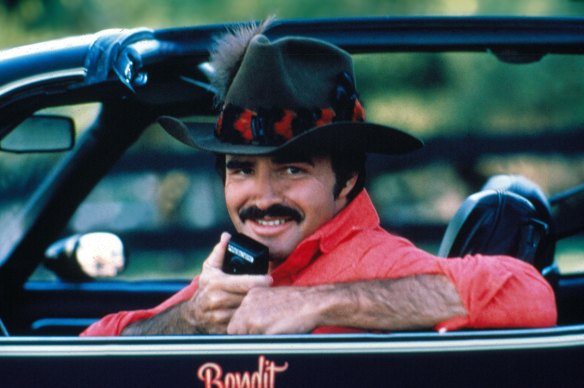This was published 5 years ago
Rollercoaster career spanned five decades with 100 movie and TV roles

Burt Reynolds holds his award for Best Supporting Actor at the 55th Annual Golden Globe Awards for his role in Boogie Nights. Credit: AP
Burt Reynolds, whose blend of Southern-fried machismo and wise-guy playfulness launched his celebrity in the 1970s, first as a freewheeling chat-show guest, then as a nude centrefold in Cosmopolitan magazine and finally as a Hollywood action star, died September 6 aged 82.
Tyre-screeching fare such as Smokey and the Bandit (1977) and The Cannonball Run (1981) largely book-ended Reynolds’ reign as a top box-office draw and cemented his on-screen persona as a carefree man’s man with an arm around a lady and his foot on the gas pedal.

Burt Reynolds and Loni Anderson.Credit: Alamy
Off-screen, the mustachioed actor developed a reputation as a hard-drinking playboy whose charm alternated with a volcanic, hair-trigger temper. He made atrocious career decisions, propelled in part by a drug addiction and dramatic financial reversals. A low point was his excruciatingly public breakup and divorce from actor Loni Anderson in the early 1990s.
Critical plaudits and peer recognition appeared wildly beyond his grasp when, in the twilight of his professional life, he summoned a precisely calibrated performance in Boogie Nights (1997) as a 1970s movie pornographer with delusions of artistry.

Burt Reynolds and Mark Wahlberg on the set of Boogie Nights.Credit: Mary Evans Picture Library
Directed by Paul Thomas Anderson, Boogie Nights earned Reynolds an Academy Award nomination for best supporting actor. He lost to Robin Williams in Good Will Hunting, but the attention seemed, if nothing else, a testament to Reynolds’s resilience.
In a career spanning five decades and more than 100 movie and television roles, Reynolds said he mostly chose projects that seemed “fun” at the time.
The rebellious son of a Florida police chief, Reynolds ventured into acting in the late 1950s after injuries pushed him out of college football. Theatre class, he wrote, was where he could find “pretty girls.”
With his pillowy lips, rugged build and unco-operative hairline, Reynolds resembled a young Marlon Brando but possessed little of that actor’s depth and subtlety. Yet Reynolds’s sexual charisma and willingness to perform his own stunts helped ease his way into the ranks of Hollywood hopefuls.
He spent the next 15 years as a journeyman in TV and movie Westerns and cop shows, seemingly doomed to serve out an artistic sentence as a C-lister. He made news in the early 1970s when he temporarily gave up his hard-living lifestyle to begin a long-term relationship with the sweet-mannered singer and TV personality Dinah Shore, who was 20 years his senior.
Reynolds’ rise to the front rank of stardom was owed almost entirely to his unpredictable and disarming appearances on late-night television with hosts such as Merv Griffin and Johnny Carson. Reynolds dispensed with the expected niceties and platitudes about Hollywood and family, and he poked fun at his career, saying he was known for movies “they show in airplanes or prisons or anywhere else the people can’t get out.”
Then director John Boorman, who once said he was intrigued by the actor’s blend of “power, vulnerability and style,” provided Reynolds with his breakthrough role in Deliverance (1972): an overconfident Atlanta businessman whose canoeing adventure with three friends in Appalachia turns into a gruesome tale of backwoods rape and murder.
Deliverance was a revelation of Reynolds potential, but the film was released after his Cosmo centrefold appearance. Reynolds insisted the photo — he was stretched out on a bearskin rug with his arm discreetly placed between his legs — was done in the spirit of satire.
Male pin-ups were almost unheard of in mainstream ladies’ magazines, and Reynolds’ image proved a sensation, quickly selling out all 1.5 million copies. He later said his hope of being taken seriously by audiences and critics was undermined by the centrefold and may have cost him an Oscar nomination for Deliverance.
During the next several years, Reynolds appeared in more than a dozen hit movies, playing moonshiners (White Lightning), policemen (Hustle), gridiron veterans (The Longest Yard, Semi-Tough) and an aging stuntman (Hooper).
“I probably could do a film about the sewer system in Moscow and make it commercial,” he joked at the time.
The most defining roles of his career — Smokey and the Bandit, The Cannonball Run and their stitched-together sequels — drew in astounding profits on gossamer plots.

Burt Reynolds in Smokey and the Bandit II (1980).Credit: Cover Images
Smokey and the Bandit, often described as a 90-minute car chase between Reynolds and an exasperated sheriff played by Jackie Gleason, cost about $4 million and grossed more than $100 million, making it the year’s most profitable film after Star Wars.
Reynolds’ career began to skid by the mid-1980s amid bad professional decisions and personal woes. He declined the role of a retired astronaut that won Jack Nicholson an Academy Award for Terms of Endearment to make another car-chase story, Stroker Ace (1983), with his then-girlfriend Loni Anderson.
He ploughed his fortune into business ventures, including a restaurant chain that folded and left him millions of dollars in debt. He bought a private helicopter and a jet and paid two pilots $100,000 each to be at his disposal at all times.
His on-set behaviour reinforced his reputation as a mercurial bully. While making the action film Heat (1986), he punched director Dick Richards for a perceived slight. The altercation cost him $500,000 to settle and torpedoed what little good will he retained with Hollywood executives.
Meanwhile, stunt injuries and a debilitating jaw condition left Reynolds in pain that he self-medicated heavily for years with prescription drugs. Unable to eat because of jaw pain, he lost more than 27 kilograms from his 90-kilogram frame, and rumours spread he had AIDS.
As he donned increasingly elaborate hair pieces, his career bottomed out in films such as Rent-a-Cop (1987) and Striptease (1996), in which he played a debauched congressman.
Reynolds’ cultural relevance spiked anew with Boogie Nights, which brought the star effusive reviews. New York Times film critic Janet Maslin wrote that Reynolds gave “his best and most suavely funny performance in many years. Like Jerry Lewis in The King of Comedy, he gives the role an extra edge by playing a swaggering, self-important figure very close to the bone.”
Reynolds told interviewer Piers Morgan that he was proud of his Boogie Nights performance but not the movie, which he said “glamourised” the porn industry. For that reason, he declined to promote the film, alienating himself from the Hollywood establishment as it was ready to embrace him once again.
Burton Leon Reynolds was born in Lansing, Michigan, on February 11, 1936, and grew up in Riviera Beach, Florida. He said his upbringing was defined by a remote and intimidating father he could never please.
After withdrawing from Florida State University’s football program, Reynolds joined a theatre class. The instructor liked the spark of rage in him and urged on his stage career.
It was only after showing that looser side of himself on talk shows that important Hollywood directors began to notice Reynolds’ potent mix of humour and sexual threat. Woody Allen hired him to play a sperm switchboard chief in Everything You Always Wanted to Know About Sex * But Were Afraid to Ask (1972).
As his career waxed and waned, so did his often turbulent personal life. His first marriage, to British actor Judy Carne, ended in divorce in the mid-1960s. She later was the “sock-it-to-me” girl on Rowan & Martin’s Laugh-In. Reynolds was also involved with actor Inger Stevens when she committed suicide in 1970. He spent years dating his Smokey co-star Sally Field.
Reynolds became a tabloid staple during his divorce from Anderson, a star on the sitcom WKRP in Cincinnati whom he married in 1988. Celebrity magazines had once covered “Burt and Loni” as a Hollywood golden couple, with Reynolds portrayed as a Lothario finally ready to settle down and Anderson as the blonde bombshell who tamed him.
As their marriage disintegrated in the early 1990s, they traded accusations of flagrant infidelity and waged a bitter custody battle over their adopted son; they eventually shared custody. They wrote duelling tell-all memoirs and were widely described as a textbook case of how not to divorce in Hollywood.
Reynolds declared bankruptcy at least once — and made efforts to revive the sly charm that once enticed millions of ticket-buyers.
“I go to the studios,” he told the Times in 1996, “and we start off and they’re very nice and they tell me they grew up with me and then somewhere in the middle of the meeting they say, ‘We have to address this — are you difficult?’ And I say, ‘If I met you between 1972 and 1976, I’m sorry'.
“At that moment, I hope for a laugh, but usually don’t get one, and then I think, what am I saying? I made a lot of money and had a lot of fun and made a lot of movies you probably loved, but, ‘I’m sorry’? I had a good time.”
Survivors include a son from his second marriage, Quinton.
The Washington Post